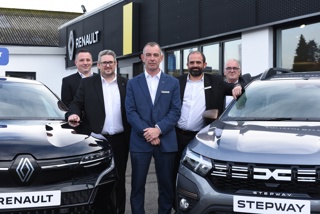Car companies will increasingly apply an omni-channel strategy to market and sell their cars to customers, writes Sarwant Singh, global practice director at automotive analysts Frost & Sullivan.
About 4 per cent of all new cars sold in future, equalling about 4.5 million units, could be sold completely on-line by 2020, which compares to approx. 5000 new cars sold solely on-line in 2011.
New cars will be sold via a number of channels, leveraging the existing dealer network and new flagship stores, but also through online and mobile channels, with sales staff even travelling to customers to showcase the vehicles digitally.
In 2009, only 4 per cent of all retail sales globally were on-line; a trend which accelerated to about 11 per cent of all sales in 2011.
In certain industries, like publishing and entertainment, the leading retailers already collect over 50 per cent of their revenues on-line which has forced the shut down of major brick and mortar stores like Borders in the US who have failed to follow the trend.
In the UK, Best Buy opened 11 new mega stores which were selling from £10 Kettles to $100,000 Tesla's, but had to shut them done within 18 months of its opening as it failed to read that one in four customers were buying electronic products online and used their mega stores only for browsing.
Could this happen to the car dealerships too in the future?
Yes it can and dealerships need to therefore innovate. The good news is that most OEMs are already experimenting or planning to get into the on-line bandwagon.
Ford UK sells new cars through its website (http://www.fordretailonline.co.uk/) and similarly Dacia (http://www.dacia.co.uk/) has entered the UK market primarily pushing its online sales channels with dealerships for back up.
Upcoming Shop-Click-Drive website (http://shopclickdrive.com/) is General Motors' new initiative to sell cars on-line in association with its participating Chevrolet dealers. New car OEMs like Tesla (for Model S, X) and Fisker (for Model Atlantic) are already facilitating complete car buying process online with assistance to its customers in different geographies.
Short-term success of Subaru, Fiat, Smart and Volkswagen with online auto channels like eBay, Taobao, Jindong, Alibaba and Gilt.com is expected to pave the future of possibly also using other independents platforms for pushing their products.
Car companies are also planning to use Fashion Merchandising online in the future e.g. Fiat500byGucci and Fiat500byDiesel.
This trend is also visible with premium OEMs like Jaguar which targets to sell its first 30 models of XJL Ultimate via online retail.
OEMs will choose either an evolutionary approach or a completely revolutionary, omni channel approach.
In the evolutionary, 'bricks and clicks' approach, car retailers are expected to operate both brick & mortar dealerships and online / mobile showrooms in independent silos. The key aim is to replace the salesman in the dealership store with an online system. The delivery of the vehicle is to happen at dealerships.
The revolutionary, omni-channel approach will operate one unified integrated channel of bricks and clicks where the entire new car buying process is carried out online (mobile and non-mobile) including finance and insurance deals, with minimal to possibly no need for brick and mortar dealerships in the future.
However, there are two important dimensions to the new car buying process - the emotional and the physical touch - that need to be mastered to create a winning click business. In the emotional dimension customers typically need to be able to have empathy with the brand and the vehicle, and it needs to be able to infuse emotions.
Then the physical part involves the touch & feel of the metal, the leather and the drivability, handling and steering feel of the car.
Both these dimensions can be enhanced, and not diminished, by the online channel and OEMs are developing new creative ways of digitally enhancing the emotional feel of the vehicle through simulations, augmented reality and showing how the car is born and delivered through cameras on the shop floor.
For the test drive, OEMs like BMW are creating new solutions like BMW on demand where one can rent, even if not afford, the high end models by the hour at realistic prices. Car companies are also working with car sharing and rental companies to provide test drive experiences.
The future will see car companies pushing real estate price by opening flag ship digital stores in expensive streets in major cities of the world like Audi and its Audi City (http://audi-microsites.com/audi-city/en/). BMW plans to use flagship stores like the one in London's most expensive street Park Lane, with dedicated staff providing information and marketing for its new iBrand.
One of the key macro to micro implications of this mega trend is that we will see shrinkage of dealership space by about 20 per cent and it will pave way for digitalisation of the dealership stores, with interactivity with the customer as a key focus.
The role of the salesman will have to change to be more of a facilitator, and training the sales force will need to evolve.
OEMs will have to also invest in an integrated channel strategy and IT platform which will need to be able to scale up their offering to country-wide solutions from day 1 as internet buyers can be sitting and ordering anywhere in the country.
Car retailers will have to look towards futuristic technologies such as augmented reality and gamification into training for their dealership staff in order to motivate and inspire sales staff.
Premium automotive OEMs are taking guidance from leaders in the consumer industry especially in luxury (Burberry) and electronic retail (Apple) to understand the implications to their retail strategy.
By 2020 China and Europe will be the key markets to promote the growth of new car eRetailing followed by the US.
The latter market currently faces large scale hurdles in implementing online new car retailing due to state franchise laws and universal opposition by evolutionary new car dealers.'
About the author: Sarwant Singh heads Frost & Sullivan’s automotive and transportation practice, and these findings are based on two recent studies, 'Brick and click in retailing' and the 'Future of new car eretailing in the automotive industry'.
AM event: the AM and RAZSOR Digital Marketing Conference will offer expert advice, tangible solutions and best practice guidelines to better equip dealers to engage fully with today’s sophisticated digital consumer.
Join us on Wednesday 13 February to plan your dealerships online strategy with clarity, confidence and cost effectively.
Cutting through the jargon and the junk, this conference explores all aspects of the digital sphere, including; social media, online classifieds, Google, SEO, tablets, apps, mobiles, video and live chat. We will also look into the future and see what lies on the horizon to help delegates stay ahead of the competition.
Event website: www.am-online.com/am-digital-dealer/


















Login to comment
Comments
No comments have been made yet.